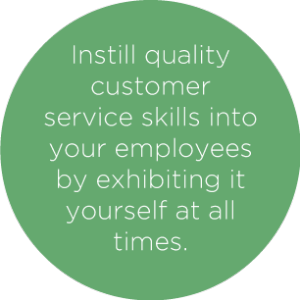The phrase “You’ll attract more flies with honey than vinegar” is usually uttered for interpersonal situations – young lads learn this fairly quickly as the playground flirting tactics of picking on (punching, chasing, teasing) the cute girl they like will prove themselves ineffective faster than the same boys will outgrow their 2nd grade pair of pants. People like being treated nicely, and that same cute girl is much more likely to reciprocate the boy’s advances if he treats her kindly – hence the phrase.
But it applies to the business world as well, specifically if you want to have the best customer service possible. But if good customer service is honey attracting flies, bad customer service is far worse for flies than simple vinegar – it’s like a gigantic, 1,000 watt bug zapper that’s always on and can fry anything from miles away. Nothing will harm your brand or your business quicker and more irreparably than poor customer service.
How to ensure you and your employees are always providing the best customer service
For many small business owners though, therein lies the rub. While you can (usually) count on yourself to provide excellent care and service for your customers, you likely can’t interact with every person that comes through your doors. Employees are a vital part of the vast majority of businesses, but for small businesses in particular, the entry-level positions tend to be on the lower end of the hourly wage scale, which by its very nature tends to have a lot of turnover. Hourly wage employees have little to no vested interest in the business as many are young and all tend to view it as a job, rather than a career.
Short of hovering over every employees’ shoulders during every interaction with a customer, how can you safeguard against letting bad customer service creep into your business? What steps can you take to get your employees to buy into valuing customer service as highly as you, the owner, does?
1. Make them Vested
As stated above, often times with small businesses, entry-level employees are overwhelmingly paid on an hourly basis and usually not too far above minimum wage. This is usually due to the business not being in a financial position to make cashiers and stock boys into salaried positions. But there are ways to increase the value of your entry-level employees’ position without necessarily increasing their hourly wage (although that is something to consider…more on that in the next bullet).
What many small business will do is hand out a bonus or bonuses to their hourly staff during the year that is a percentage of the total revenue brought in during a set period. The percentage can be whatever makes sense for your business and how successful it was during the time period in question, but even a small kickback will go a long way in fostering good relations with your lower-level staff. Many small businesses do this to serve as the Christmas or holiday bonus – all employees receive a percentage of the revenue brought in during the year. Not only will it help your employees’ finances during the high-spending holiday season, it will also encourage them to perform better, and give the best customer service they can, as they are directly vested in your business’ revenue. The more that’s brought in, the more they’ll receive at the end of the year.
 Another option is providing them with shares in the company. Start them off on a trial period when first hired to make sure they’re a good fit… then, after three or six months, offer them a small amount of shares that will increase with their tenure at your company. You can even provide them with the option to purchase more with their own mondey. Sleep Train Mattress Centers have done this over the recent years and have been lauded for the move, by both the employees that work there (and are now partial owners) and by the customers who shop there who are greeted with friendly, quality service from staff members that have a vested interest in their company’s success.
Another option is providing them with shares in the company. Start them off on a trial period when first hired to make sure they’re a good fit… then, after three or six months, offer them a small amount of shares that will increase with their tenure at your company. You can even provide them with the option to purchase more with their own mondey. Sleep Train Mattress Centers have done this over the recent years and have been lauded for the move, by both the employees that work there (and are now partial owners) and by the customers who shop there who are greeted with friendly, quality service from staff members that have a vested interest in their company’s success.
2. Treat them Equitably
Not every employee you will hire is going to be a perfect fit, but by treating them all fairly and justly, you’ll be doing your best effort to ensure that you’ll be getting their best work in return. Too often, business owners look at the lower rungs of their staff as completely dispensable – if your dishwasher or janitor isn’t happy with his or her hourly wage, they can leave and you’ll more than likely be able to fill their position relatively quickly. While not necessarily incorrect, this mindset can and most likely will lead to faster-than-necessary turnover and company instability.
If you view your entry-level employees as an investment, you may very well be rewarded with a higher-quality output of work and could even find a diamond in the rough capable of moving up the chain. The operative word there, however, is investment – quality employees don’t come easy and are worth your money. A Bloomberg Businessweek article in April of 2013 compared the financial plight of Costco versus their chief competitor, Wal-Mart. Costco’s year-over-year growth was a formidable 8%, while Wal-Mart’s was a paltry 1.2. One of the biggest factors in this is that Costco pays their employees a respectable, livable wage – an average of $17 per hour compared to $9.60 at Wal-Mart. This leads to happier employees, better customer service, and most importantly for you, better sales – sales per employee at Costco were nearly DOUBLE the sales per employee at Wal-Mart.
As Harold Myerson of the Washington Post states: “One lesson that emerges from the experience of low-end retailers is that putting workers in crummy, low-wage jobs tends to yield crummy service as well….Costco and Trader Joe’s pay their workers far more than many of their competitors, offer their employees opportunities for promotion and enjoy markedly lower worker turnover and far higher sales per employee than their low-road counterparts.”
3. Provide Solid Training/Education
A core tenant of providing good customer service is to be knowledgeable and be able to answer all the innumerous (yet reasonable) questions your customers may ask. If you run a paint shop, your employees better know the ins and outs of glossy versus satin finish, the best roller nap length for interiors versus exteriors, when oil-based primers are better than latex-based…the list goes on and on.
 And be sure that it’s not just the sales people that know this stuff intimately – while they’ll definitely receive the bulk of the questions, there will be times when the only person around is your cashier. If all they can do is shrug and say “I don’t know” when a customer ready to make a purchase but has a question, that’s poor customer service and most likely a lost sale.
And be sure that it’s not just the sales people that know this stuff intimately – while they’ll definitely receive the bulk of the questions, there will be times when the only person around is your cashier. If all they can do is shrug and say “I don’t know” when a customer ready to make a purchase but has a question, that’s poor customer service and most likely a lost sale.
If you look at the best customer service providers out there, industry-related knowledge is a must, but so is building-related knowledge – every employee should know where your merchandise is precisely and be able to point customers to exactly where they need to go. Also, make sure part of the training includes basic, industry-agnostic tenants of customer service, such as having patience, how to handle upset or irate customers, conflict resolution, etc.
4. Lead By Example
One of the most effective ways of instilling quality customer service skills into your employees is to exhibit it yourself at all times. Many business owners feel that they are above reproach when it comes to dealing with their customers, but oftentimes they can be biased toward judging themselves in this arena, and often will let the emotion of having their livelihood at stake cloud the issue.

It can never hurt to periodically remind yourself of the basics: always be enthusiastic and greet customers with a warm welcome and smile; the customer might not “always be right” but always give them the benefit of the doubt; be patient and always listen intently to the customer’s needs and concerns; honor your word and never make promises or claims that you cannot keep or back up; always follow “The Golden Rule” and treat your customers in the precise manner you would wish to be treated had you been in their shoes; if the customer asks for something that’s slightly outside of your responsibilities, go the extra mile and take care of it if the request is within reason.
A good employee will constantly look to their supervisors for knowledge and how to act – make sure that you practice “trickle-down” customer service to set a good example. And if employees aren’t picking up on it, they’re probably not worth the time to keep employed.
For the best customer service, be willing to listen to customers and learn from your mistakes
Bill Gates once said,“Your most unhappy customers are your greatest source of learning.” While the goal of every business is to have 100% satisfaction rate for all customers, it simply won’t happen – the realistic goal should be to get that percentage as high as possible. However, Mr. Gates is on to something – when you inevitably get unhappy customers, listen intently to why they are unsatisfied. Some will be irrational just for the sake of being irrational, but you will learn from the rest any possible holes or gaps in your business’ customer service. They may inform you of an employee being rude or unhelpful, or they may simply tell you that you need to carry more of a particular item. Regardless, be willing to listen to them and learn from your mistakes – being agile and able to improve in areas where customers are dissatisfied will only improve your business’ overall customer service, and thus success, in the long-term.






Thanks so much. This was very informative